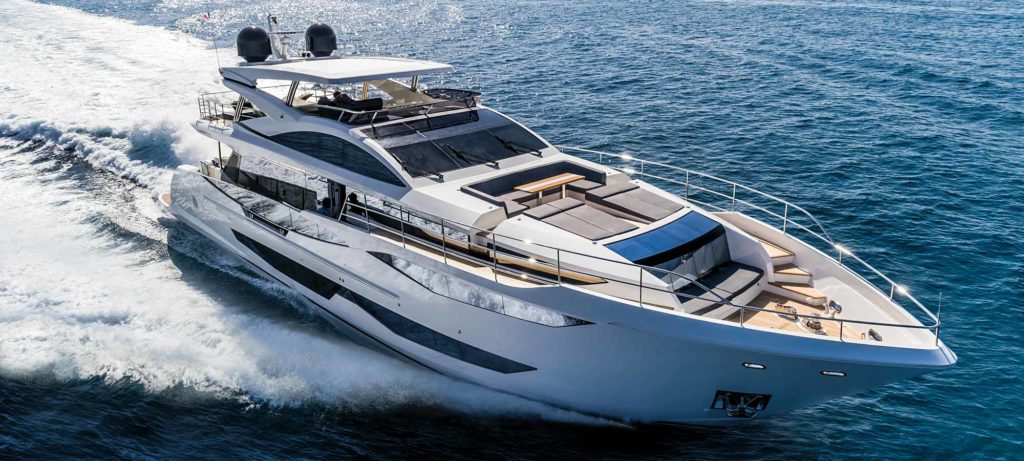
As with her smaller sisterships, the Pearl 65 and Pearl 80, Bill Dixon’s U.K.-based design studio was responsible for all the practical elements that make up this feature-rich semi-custom yacht. And, as with the Pearl 80, Kelly Hoppen created the 95’s high-style, low-key interior.
The Pearl 95‘s profile includes a great deal of side glazing. It is visually busy, but the long hull-side windows, with all the main-deck glass such as picture windows and double-width doors, deliver vista views and vibrancy to guests looking out from the inside. And all the glass gives the yacht a sporty exterior look, one that creates the impression of a two-decker with a flybridge as opposed to the raised-pilothouse design that this yacht actually is.
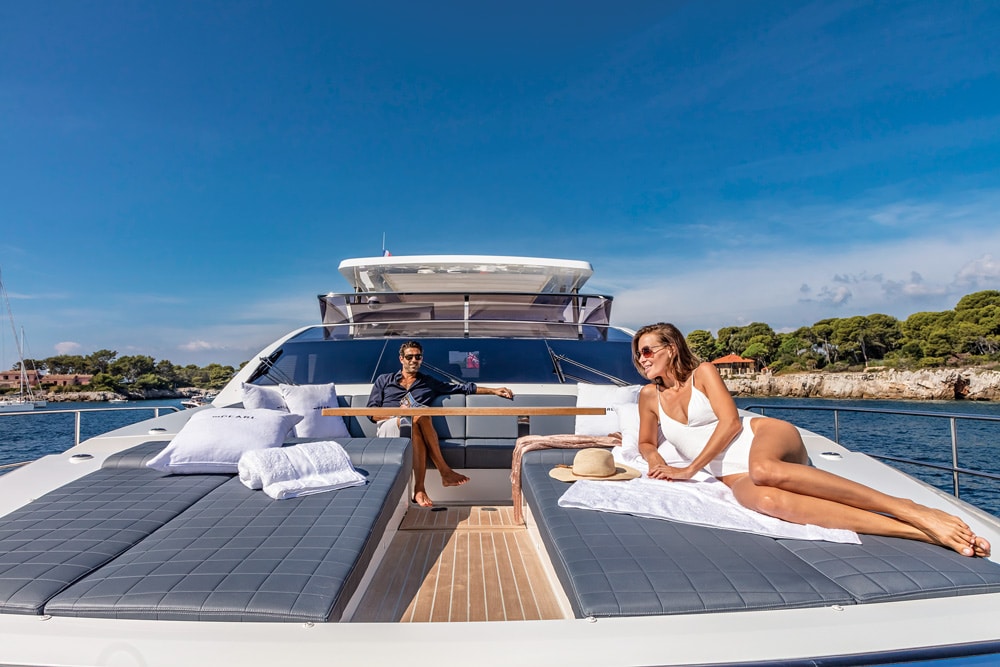
The outdoor spaces aboard the Pearl 95 start with an almost 450-square-foot flybridge. A hardtop covers most of it, and an electric sunroof allows 150 square feet of ultraviolet exposure at the flick of a button.
On the foredeck is more prime real estate, whether used at anchor during the day or while moored stern-to in a marina at night. The yacht’s 21-inch-wide side decks, tucked inside 4-foot-high bulwarks, lead to a split-level setup. The main area beneath the windshield includes a C-shaped sofa, table and sun pads. The other level has a built-in sofa.
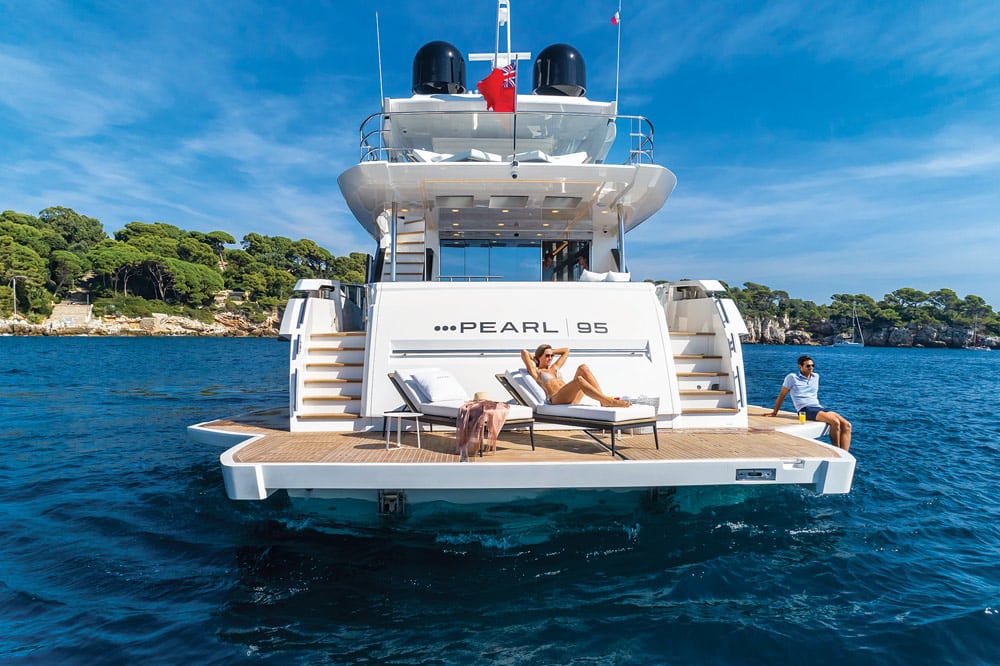
Aft is yet another relaxation space. The beach club has a couple of surprises, including two fold-down, teak-laid quartering platforms, which fit nearly flush with the hull when stowed (only the arcs of the joints are visible). When down, the platforms flare out the stern. Coupled with the hydraulic platform, they deliver a wraparound effect. Even with just the starboard-side platform down, there’s space for a small table and a quiet breakfast.
Given that the yacht’s maximum beam is almost 22 feet, the 1,737-pound-capacity hydraulic platform aft should take a 16-foot-4-inch-long tender. The garage, according to the builder, can hold a three-seater Kawasaki Jet Ski and still leave room for a wet bar. When left up, the garage door serves as a sun awning.
Inside, the decor is one of informal luxury. Muted taupes, milky whites, grays and browns soften the punch between dark chocolate, high-gloss wengé and the sheen of ice-white gelcoat.
The 95’s salon has a conventional layout: a lounge aft with a dining area forward. The free-standing furniture comes from the Kelly Hoppen Interiors collection. What makes this area special is the extravagance of empty space. Roughly one-third of the salon serves as a wide passage to the starboard-side companionway. When both sets of sliding doors are open to the aft deck, the salon feels doubly large.
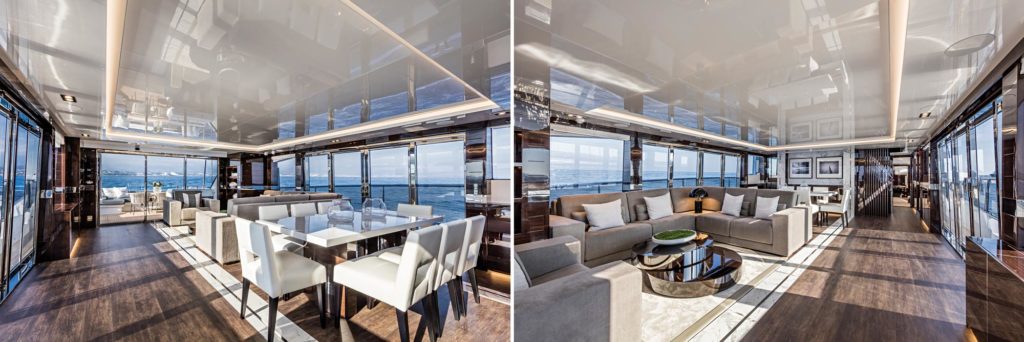
From the starboard-side companionway amidships, guests can step down to four staterooms: two transverse doubles and two twins, all en suite.
The owner’s stateroom is forward on the main deck. Remember the glass from the exterior? The entrance to the master stateroom includes a walk-in closet, shelving and a vanity, beyond which are a forward-facing king-size bed, twin chairs, a table and a corner desk, but all eyes are drawn to the eight panes of glass that dominate the forward wall. There are four fabulous views out to the foredeck as well as four views skyward, with concealed blinds for privacy. The double-height side windows allow views for guests who are seated or in bed. In all, the master stateroom occupies around 247 square feet, with 87 square feet for the en suite head.
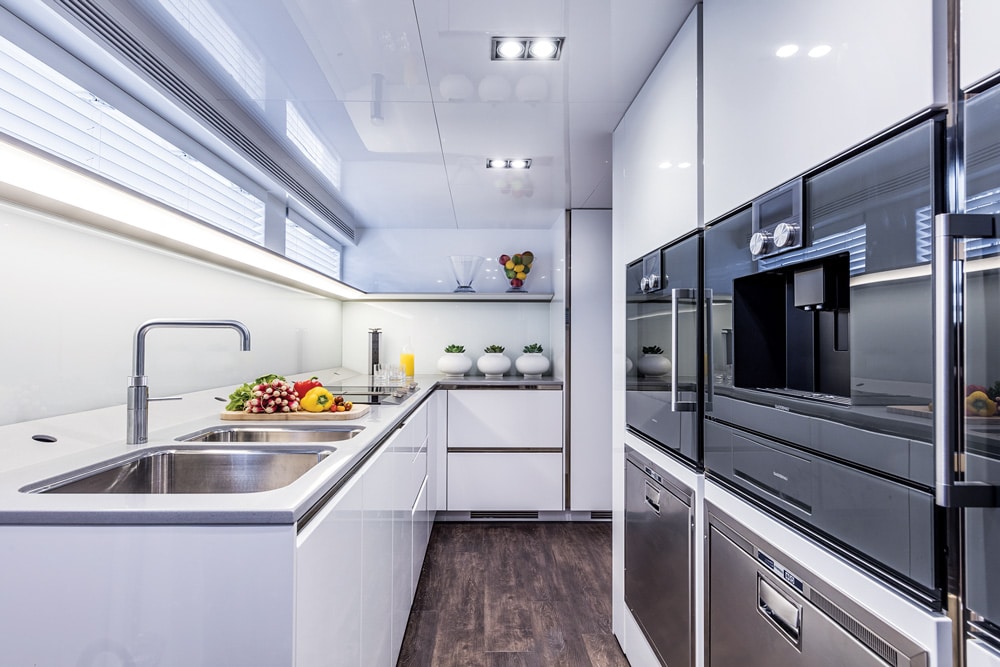
The Pearl 95 that I got aboard was Hull No. 1, and it had twin 2,400 hp MTU 16V 2000 M96s, ZF V-boxes and five-blade CJR propellers. At something over the quoted 209,000 pounds of half-load displacement with 11 people, 30 percent water and 100 percent fuel on board, the yacht managed just over 26 knots at full chat, shy of the builder’s reported 28-knot top-end. With pre-commissioning tweaks, she’d likely get there.
As for range, allowing for a 10 percent reserve, expect around 250 nautical miles at 2,000 rpm and 18 knots, and more than 1,000 nautical miles at 1,000 rpm and a 10-knot plod. Pearl Yachts promotes a range of 420 nautical miles at 13 knots — and the builder is open to more than the listed engine options. The American owner of Hull No. 2 reportedly opted for a hybrid system with Caterpillar generators and lithium-ion batteries.
I was aboard in the Mediterranean Sea off Puerto Portals, Mallorca, in Spain’s Balearic Isles. There was a flat-calm sea, and it was 75 degrees Fahrenheit in the shade — hardly challenging conditions. Suffice it to say, she roared and turned on cue.
Flagships are supposed to represent a builder’s best, and the Pearl 95 does just that. It will be interesting to see how owners personalize this semi-custom yacht, making it the flagship of their own fleets as well.









